Galleries
Kenny Schachter Casts Dark Shadows Over Armory Week
The Armory Show, the ADAA, and Loic Gouzer are on Kenny's mind this week.

Image: Courtesy of Kenny Schachter
The Armory Show, the ADAA, and Loic Gouzer are on Kenny's mind this week.

Kenny Schachter

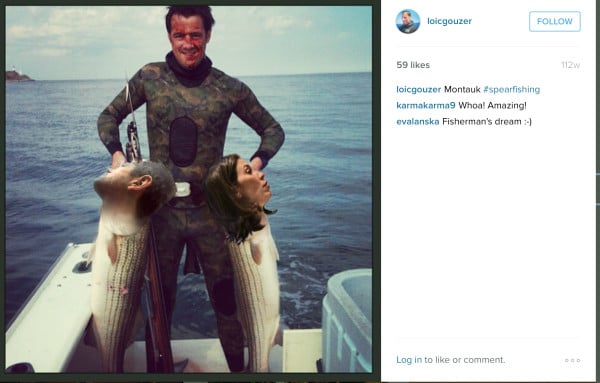
Collage by Kenny Schachter.
Image: Courtesy of Kenny Schachter
Dark Shadows
“Dark Shadows” was an epic American gothic soap opera involving a bloodsucking vampire. Though it aired weekdays from 1966–71 (I’m dating myself), it’s what the art market has come to resemble. Economic uncertainty has elevated stress levels to an art world specific strand of hypertension. Sotheby’s shares, the only stock market pure-play in this realm, have turned us into a bunch of ticker watching junior stock analysts. We are in anxious art times, bordering on skittish, but fear not folks, let me assure you, from a rabblerousing (art-dealing) rabbi to the sordid spectacle of the (scorched) auction landscape, we are in for fun times.
An unintended upside of the downtick is that consolidation and collateral damage regarding a group of emerging artists and spec-u-lectors has turned a flock of flippers straight, if not reformed them outright (and out of the art world). Flipping itself has become a fossilized footnote connoting a minor turn in the market, since passed, in a period where consideration and forethought have new gravity and meaning.
Right, I almost forget this is about art fairs, namely, ADAA’s The Art Show, founded in 1988, the Armory Show, established in 1994, the Independent, begun in 2010, and the SPRING/BREAK Art Show, running since 2012. But before I get underway, I have a few announcements, like those made at the onset of a church or synagogue service.

Cady Noland at Grant Selwyn.
Image: Courtesy of Kenny Schachter.
Market Catch-Up
Like Warhol undermining the intent of his antique-collecting friends by beating them out in the fierce pursuit of objects they had confided interest in, art dealer slipperiness and vindictiveness abounds. A fistful of people are relentlessly chasing the same art like dogs after their own tails. We should all be sporting the equivalent of the plastic protective collars that saves pets from… themselves. The same piece of art can have as many prices as the depth of knowledge of the particular buyer permits.
At one lunch alone, two Rudolf Stingel paintings were shown to me by a collector; one used to be mine and the other was maybe about to be. In today’s heightened cautionary climate, Stingel is the new Stingel—meaning that in the tightening net of what is sought after, a core group of established, classic contemporary art will flourish at the expense of less-canonized material.
Yes we all know about door-to-door drug delivery services throughout most metropolitan areas, other than say Pyongyang, but I had yet another Stingel delivered and installed in my hotel room one afternoon. Desperate times call for eager actions.
While it was an exquisite example, versus the jpeg—the digital image had obviously been tweaked to highlight the brightness of the red, always a strong selling point (call it art world Botox). That it wasn’t what it purported to be it would always have stuck in my craw. Pass.
I couldn’t pass up parsing the tale of the rabbi who was searching for signs of the word of god, and, just as fervently, a good Stingel canvas. Join the herd. But in a market truly global in scope, the rabbi hailed from Rio de Janeiro rather than Brooklyn. First he volunteered the work was sought after on behalf of a member of his congregation, then proceeded to ask me to ensure there was something in the equation for him should a transaction transpire; something the unsuspecting member of the community must have been oblivious to.
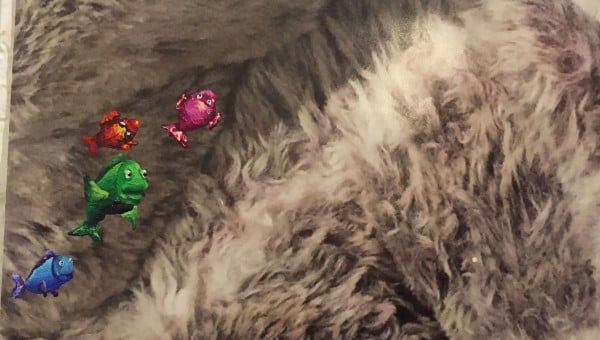
Adrian Schachter.
Image: Courtesy of Kenny Schachter
I had a call from another kind of professional the other day, though also outside the art orbit, this time a dentist-dealer seeking another major work, thankfully not a Stingel. I found a great representative piece of the artist only to be informed by the diligent dentist the painting had been the subject of a legal claim by the estate that the work had been stolen during the artist’s lifetime. Oh the joy. That’s the art world we inhabit: Lawsuits R Us.
Anyway it looks like the case definitively settled months ago; I am going to view it this week. What did my pal selling the piece, a fully-fledged dealer this time around (surprise!), reply when I brought this to his attention? “Damn, you found out.” Damn I found out? What an asshole. It used to be that selling historical art entailed checking the Art Loss Register, now you can launch a Uniform Commercial Code search for liens filed against art as collateral and any minute you should be able to add to the laundry list a lawsuit search. artnet, are you listening? This could be a new profit center.
As far as the hot button houses—Sotheby’s has been hemorrhaging staff faster than Marco Rubio is losing momentum in his presidential campaign. Soon it will be easier to count who works there instead of who doesn’t. Phillips held a New York contemporary sale at the start of the week entitled New Now. A cursory browse through the catalogue revealed art neither new nor necessarily of the now.
But what was painted in the press as a dismal sell through rate of roughly 50 percent was in fact a robust testament that there was, is, and will always be an art market. To move half of that crap alone, in and of itself, is a very positive sign, indeed. Keep in mind I directly heard from two consignors this week that weren’t paid for previously sold works from the firm. The “buyers” in such instances are banned from participating in future sales, that is, till the next time they request a paddle. By the way, I am thinking of launching a Kickstarter campaign to get a new auctioneer for Phillips.

Collage by Kenny Schachter.
Image: Courtesy of Kenny Schachter
The Failures of Loic
Loic Gouzer, the 35-year-old Deputy Chairman, Post-War and Contemporary at Christie’s—also said to be contemplating leaving the mother ship—sent out a 3:00 a.m. e-mail one recent Sunday night, replete with spelling and grammatical errors (make your own assumptions), pitching his latest for a standalone sale to take place this May. Based on the notion of failure, the show will be entitled Bound to Fail, if they can get their hands on the Bruce Nauman work of that name.
Don’t get me wrong, I am all for embracing and celebrating failure, I experience it so frequently by default; I’m considering consigning myself—not for lack of trying to accomplish otherwise. This will be a much less ambitious sale than the previous offerings, more akin to day sale mentality and with lower price points to match, from $20,000–10 million.
Gouzer’s haphazard missive that set out the parameters of his proposed auction suggested that it should take a Buddhist approach and “embrace that negative energy to then leverage it and ultimately turn all that dark-matter into gold.” The letter then goes on to slag me and Amy Cappellazzo including, among the things, that the show should feature “anything that is a bad idea or anything that will either annoy Amy Capelazzo (sic) or Kenny Schacter (sic).”
By reaching out to Christie’s executive staff and basing a tenet of his show on annoying Captain Cappellazzo and me, Loic spectacularly failed to fail inasmuch as I’m touched and flattered. And to boot he inspired me to devise a show with Amy to doubly further stick it to him. He might have taken exception to something I wrote in the past like when I described him as a Bond villain. Or was it a comment I made about his rank as a self-proclaimed spearfishing eco-warrior?
In the Christie’s e-mail, he refers to his team as a “commando-angel task force.” So much for redirecting his deleterious demeanor. I wonder if they get armbands or otherwise special outfits? To his role, I can add (Francois) Pinault’s pet. I thought it was all an accolade and I was being nice. I couldn’t imagine what Amy pissed him off about besides perhaps the enormity of her outsized Sotheby’s buyout. Strangely enough, the art world was lacking humility even before it became peopled with art and money.

Jules Olitski, Other Mother (1989).
Image: Courtesy of Paul Kasmin
The House of ADAA
The Art Show, presented by the Art Dealers Association of America (ADAA), is art fair lite—a dollhouse proportioned enterprise compared to most fairs, which gives the whole thing a boutique-y, relaxed vibe that’s easy to navigate due to the limited scale of participants, seventy-two in total. The new art world status symbol: how early gallery bosses duck out of fairs early, which for this event was before the end of the premiere. Standout booth Lisa Spellman’s 303 Gallery (Spellman is a conceptual institution herself) featured an allover mirror installation by Nick Mauss, reminiscent of another gallery artist, (the very undervalued) Karen Kilimnik and her earlier installations.
Paul Kasmin had a one-person presentation of the work of Jules Olitski with the outstanding syrupy Other Mother (1989), an acrylic on canvas work that measured 81 by 55 1/4 inches, and was selling for $240,000 (the price range was $35,000 – $750,000), fabulously, “The artist indicated this painting may be hung either vertically or horizontally.” How cool is that?
Less cool was the fact I called the gallery the next day to ask for information on the Larry Poons paintings, embarrassingly having confused my Olitski with Poons—though they are kind of fungible by way of their messy formalism, not to mention they are both marginalized like the UK’s Leon Kossloff and Frank Auerbach—they are not the same.
Not to say they might more successfully be sold together as a package deal. At nearly a quarter of a million, Olitski’s works are cheaper at auction than on the primary market, the reverse of many a young thing.
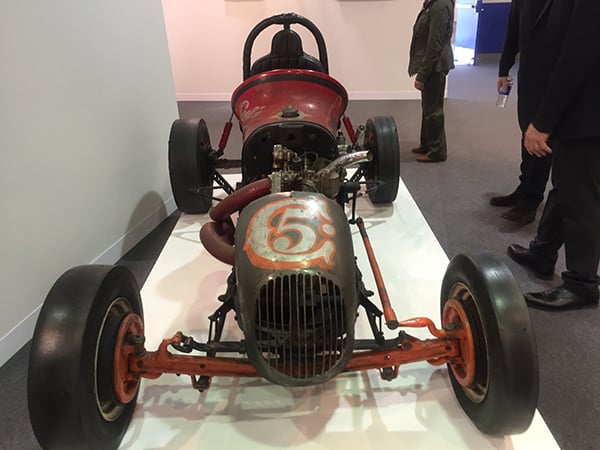
Sal Scarpitta racecar at Montrasio Arte Monza.
Image: Kenny Schachter
The Armory Show in an Age of Post-Attention Spans
Do you believe in astrology? The best synopsis of the Armory Show was summed up in my Daily Mail horoscope that I caught on the plane on the way to New York: “Welcome to a week where little goes to plan and even less makes much sense. A week full of irritation that extends at times to exasperation; but, you’ll end up with what you need and be happy with what you get.” I did and I am. If there’s any way to describe how I felt after a visit to the fair it’s that in the age of post-attention spans, I’ve lost the criteria to judge art pre-consensus. Let’s see what Benjamin Genocchio, the founder of artnet News, where I’ve been a columnist since 2014, could do to inject verve over next few years, as this year’s event is yet to bear his imprimatur.
I am drawn to the modern versions of contemporary fairs lockstep with the extent of grey hairs emanating from my nostrils. Anyway, we are in a super selective market that has contracted for all but a handful of recognized artists and will continue to do so. The emerging section of the Armory Show is age appropriate in its inconsistency other than Richard Artschwager’s depiction of a rocket flying higher than his market, but managing to sell for $350,000 from Thaddaeus Ropac. It’s a great work, but is it too grisaille to ever be considered groovy?
At the modern wing, which is disconcertingly on a different pier and floor, there was a group of three tiny hand-torn paper works by Cady Noland priced from $45,000 – $145,000, from the early 1990s at Grant Selwyn. The works were first shown at the inimitable Colin de Land’s gallery American Fine Art in the early 1990s. The best work was of course instantly gone. Then, low and behold, after my Kasmin mishap, there was a significant Larry Poons painting, Black Ovation (1982), selling for $75,000 at Danese/Corey. The work, at 79 by 55 inches, cost less than a similarly sized Lucien Smith rain painting—nuts.
There was also a Sal Scarpitta racecar sculpture made for Leo Castelli’s son at Montrasio Arte Monza. Not a shabby provenance, but at $650,000 you are in similar territory as an Alfa Romeo Autodelta Corso from 1965 with racing history. With the added benefit that the Alfa could manage the school run, though admittedly loud and unwieldy.
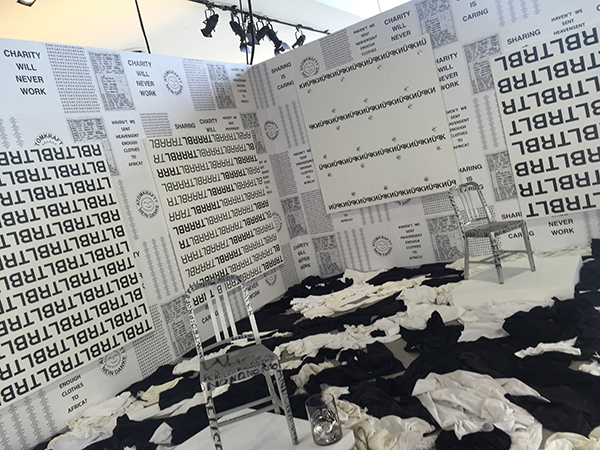
Karl Holmqvist installation at Gavin Brown’s enterprise booth at Independent.
Image: Kenny Schachter
Independent Spirit
The Independent, like NADA, and the Armory before them, moved to bigger, more professional digs than the Dia building, and not necessarily to better effect. Fairs are trading up the property ladder and I bet we see a purpose built fair venue soon. Karl Holmqvist’s all-over text installation was on view at Gavin Brown. I’ve worked with Holmqvist in the past (in the mid 90s pop-ups I curated). When I reminded Gavin Brown of the frequency that his program coincides with my curatorial past—including shows I’ve done with Joe Bradley, Spencer Sweeney, Rob Pruitt, and Jonathan Horowitz (who created a sensational centerpiece at Frieze New York this past year), he said he found it bothersome. Seems like a constant in the art world. Nate Lowman paintings were on view at Maccarone, many seemingly still available at $240,000–280,000, indicating just how quickly the art market can change course—swifter than nuclear fission.
Spring Breakers
SPRING/BREAK was for meanderers, not shy or impatient types (like me). At Seth Sgorbati, ex-Mary Boone (bless him), there was a 1987 Barbara Kruger collage, as minute as the Cady Noland at Grant Selwyn, entitled The Price is Right. So, of course, the first thing I asked was the price. He asked me not to mention the $90,000 price, so let’s keep it among ourselves. After cheekily trying for a 30 percent discount, I got my due when he sold it out from under me for more. This punk-ish fair had the best spirit of the lot, maximalist in terms of layout like the clutter that is my house. Daunting, yes. Forget Loic, these are the real warriors, by far.
I caught the not-to-be-missed Fischli and Weiss retrospective, “Peter Fischli David Weiss: How to Work Better” at the Guggenheim that radiates what must have been the sheer, unbridled joy that went into the making of the works on view. This is art as comedy-craft formally and in the concrete poetry of their titles. The crazy skill is unfathomable coupled with which such goofiness made high. It’s moving.
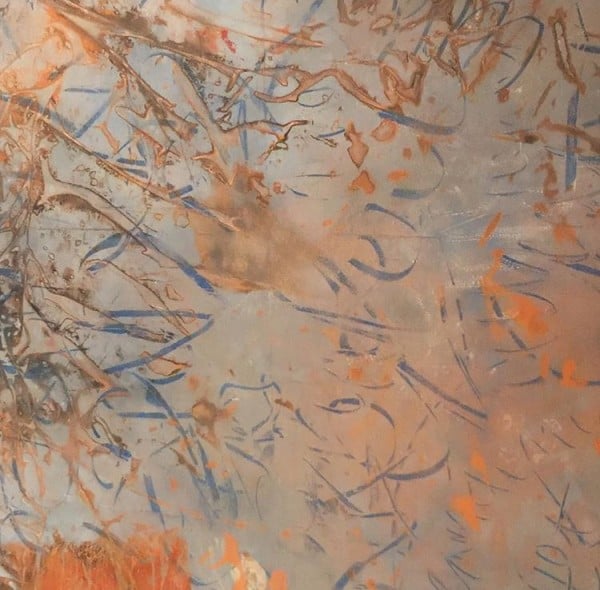
Kai Schachter.
Image: Courtesy of Kenny Schachter
Say Yes to Nepotism
Say yes to nepotism! “Rubbish” is the exhibition incorporating the work of two of my (four) kids, Adrian and Kai, and a few others. Curated by Caio Twombly, the show includes photographs by Jonah Freud, respectively Cy and Lucien’s grandsons. Seriously, art is a language that binds us beyond family. Is passing down an art legacy necessarily a good thing? Well, if they’re worthy, great; if not, then no. But of course, the show is remarkable.
Ok, so it didn’t get off to an auspicious start when Adrian and Kai failed to recognize Walter Robinson, who we had dinner with not too long ago when he passed by the space. Not good for Kai, my aspirant zombie formalist, a term coined by Walter (Kai hates when I needle him with the reference). One of their BFF’s retorted during the opening, “I wasn’t expecting it to be this good.”
They nearly sold out, and with prices up to $5,000, things can’t be all that bad—admittedly, it’s a number that might give pause…. But then again, we’ve entered the day of the discount, so ask away. You have to admire their gumption. Finally, I’m getting some return on investment after the long slog.
Adrian, my soon-to-be 20-year-old, painted demented elves and mischievous fish in throbbing colors over photographs. The sly, good-natured humor of the characters belies the careful application of thick paint. Adrian elevates cuteness to an art form bringing to mind the clay sculptures of Fischli and Weiss. The slacker insouciance of the just-shy-of-nineteen Kai can’t mask his painterly precision. Kai incorporates text in the form of words and sentences such as “What,” his constant refrain to any unsolicited query, as well as scrawls of abstracted language that goes in and out of focus. And also, a beautiful serene color sense.
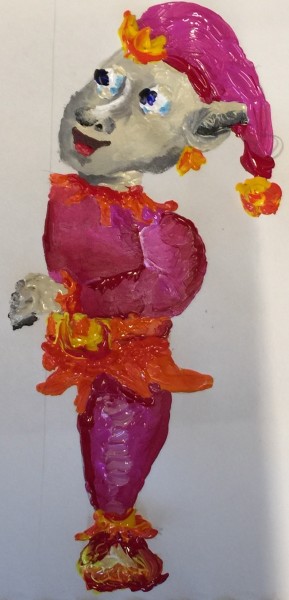
Adrian Schachter.
Image: Courtesy of Kenny Schachter
At the opening, I spied a couple stealing bottles of booze from the bar after having drinks too numerous to tally. When the man puked on someone’s leg, I realized I’d come full circle, being nostalgically reminded of the 1990s. Also precarious economic times, it was a period when I curated dozens of shows with openings frequented by a hodgepodge of lunatics and sociopaths, proof that things never change.
No offence to the naysayers but they are all wrong. Quality, (even) midlevel, stuff by the likes Mike Kelley, Bruce Nauman, Christopher Wool, Robert Gober, Louise Lawler, Gerhard Richter (just sold two of his works in the last two months), Barbara Kruger, Rosemary Trockel, Joan Mitchell, and buckets of others is sounder than ever. Of course connoisseurship is more essential than ever but that’s a good thing, no? This market could be wildly well-traded. I see nothing approaching a 20 percent correction, a number that’s been bandied about in the press. Reduced auction volume is a thing in itself and if the art market wasn’t affected by the unprecedented extent of such a global meltdown it would be, well, quite a spectacle.
Hitting up Armory Week in New York is like living in a tunnel. You are hard-pressed to follow anything but the art . Things at reasonable price points are moving, though tolerance for emerging art is way down from $100,000–300,000 (where it was a year ago) to about $10,000–30,000.
The Geiger counter of a good fair is what, if anything, you have coveted. For me, it was the micro Noland and Kruger, both of which I failed to snag. Nevertheless, there’s always something to look (at), learn, and love. Fischli and Weiss clearly relished making art while there are those inexorably predisposed to buying (and accumulating) it. Nothing will foreseeably curtail either camp now, or forever.